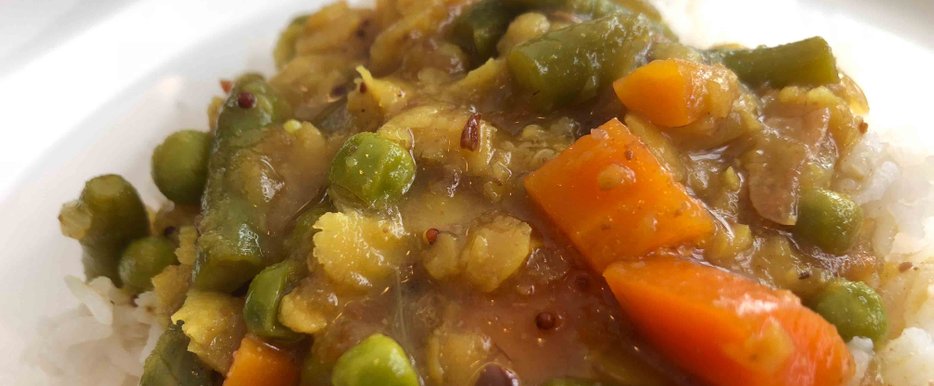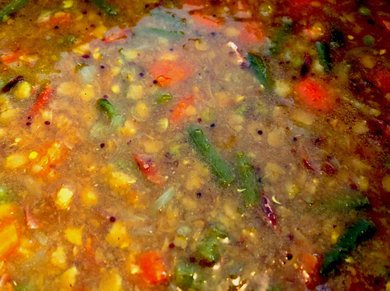Sambar
Sambar, also spelled sambhar or sambaar, is a lentil-based vegetable stew or chowder cooked with a tamarind broth originating from the Indian subcontinent. It is popular in South Indian and Sri Lankan Tamil cuisines.
According to food historian K. T. Achaya, the earliest extant mention of sambar in literature can be dated to the 17th century. According to a story, the dish was accidentally invented by the Maratha ruler Sambhaji, who added tamarind while making dal soup, when his head chef was away.
Sambar is made either exclusively with one of these vegetables or a combination of them:
- okra
- moringa
- carrot
- radish
- pumpkin
- potato
- tomato
- brinjal (eggplant)
- whole or halved shallots or onions.
Sambar often contains sambar powder, a coarse spice mix made of roasted lentils, dried whole red chilies, fenugreek seeds, coriander seeds and sometimes asafoetida and curry leaves. Regional variations include cumin, black pepper, grated coconut, cinnamon, or other spices.
Sambar is reflective of a broad and ancient tradition of lentil-based vegetable stews in southern India. In regions that grow coconuts, notably some areas of Kerala, coastal Karnataka and Tamil Nadu, Sambar is made with a paste of fresh, grated and roasted coconuts and spices, instead of sambar powder.
In Andhra Pradesh, it is called as Pappu chaaru. Apart from dal and tamarind, vegetables used in preparing is few. Vegetables are onions, dosakaaya, bitter gourd and tomatoes.
Sambar is usually served with steamed rice as one of the main courses of both formal and everyday south Indian cuisine. A two-course meal of sambar mixed with rice and eaten with some sort of vegetable side dish, followed by yoghurt mixed with rice, is a prime southern Indian staple.
Vada sambar and idli sambar are popular for breakfast or an evening snack in the south Indian states.
Sambar is also served as a side dish for dosa.
 Recipe Servings: 4
Recipe Servings: 4
 Cooking time: 30 Minutes
Cooking time: 30 Minutes
Ingredients
- Arhar dal (Toor Dal/Pigeon Pea lentils) - 1/2 cup
- Chopped Vegetables (Okra, French Beans, Carrots, Bottle Gourd, Peas) - 1-1.5 cup
- Onion (finely chopped) - 1
- Tomato (finely chopped) - 1
- Green Chillies (finely chopped) - 2
- Garlic (sliced lengthwise) - 3-4 cloves
- Cumin Seeds (Jeera) - 1 tsp
- Tamarind pulp (seedless) - 1/2 tbsp
- Turmeric Powder (Haldi) - 1/2 tsp
- Red Chilli Powder - 1/2 tsp
- Sambar Powder - 1-1.5 tbsp
- Dry Red Chillies - 2-3
- Curry Leaves - 10-12
- Salt to taste
- Oil - 3 tbsp
- Water - 2.5 cups
Preparation
- Soak tamarind in warm water for approximately 30 minutes.
- Then mash it with hands or spoon. Strain it with the help of a sieve and discard the solid part. Tamarind puree is ready, keep it aside for later use.
- Wash dal several times. Add washed dal in a pressure cooker and add 2.5 cups of water.
- Add chopped vegetables, finely chopped green chillies, finely chopped onions and finely chopped tomatoes into it.
- Now add cumin seeds, red chilli powder, turmeric powder, salt and 1 tbsp of oil.
- Pressure cook for 4 whistles on a medium flame. Dal needs to be cooked till soft and smooth.
- Allow the steam to escape and then open the lid.
- Add sambar powder and already made tamarind puree into it. If the consistency of sambar is thick you may add water as per the desired consistency.
- Keep the pressure cooker on stove/gas and simmer the sambar for about 12-15 minutes.
- Keep on stirring occasionally so that dal does not stick to the bottom.
- In a small pan take 2 tbsp of oil. Add mustards seeds into it.
- When mustard seeds begin to crackle add curry leaves and lengthwise sliced garlic into it.
- Broke dry red chillies into 2 pieces and add them into the seasoning.
- Cook it till garlic turns into golden brown and red chillies changes colour.
- Pour the seasoning into the hot sambar.
- Mix it well. Simmer for 2-3 more minutes.
- Sambar is ready to serve.
- Serve it hot with Plain Rice or Idli or Vada or Dosa.



